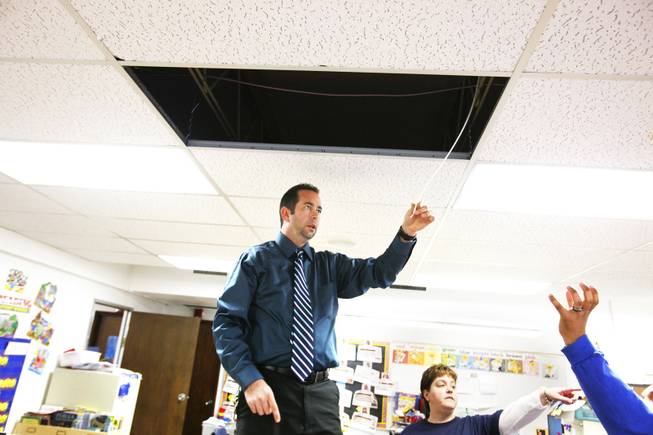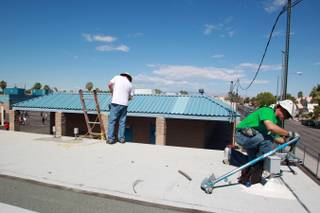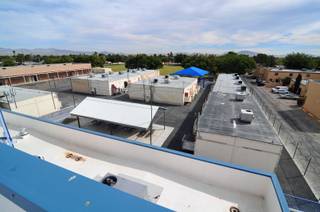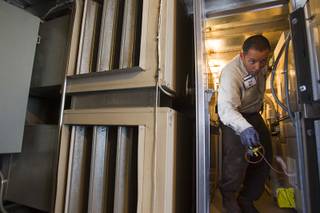
Principal Tim Adams of Rex Bell Elementary School checks out a roof leak on school grounds in Las Vegas Wednesday, Dec. 14, 2011.
Wednesday, Feb. 5, 2014 | 8:15 p.m.
Sun coverage
The Clark County School Board is considering a tax initiative or bond program to raise money for school renovations and construction.
A ballot question could go before voters as early as November, but it would face competition from another measure to raise taxes for education.
The Education Initiative, proposed and backed by the teachers union, would impose a 2 percent margins tax on Nevada corporations with more than $1 million in annual revenue. Proponents estimate the tax would raise $800 million a year for Nevada schools. Business groups oppose the tax, arguing it would stifle the state’s economic recovery.
With a contentious tax initiative for education already on the 2014 ballot, the School Board is likely to wait until the 2016 election to put its own ballot measure before voters. The board decided Wednesday to delay its vote on the matter, seeking more information from staffers.
“My belief is that we should probably go in 2016,” said School Board member Carolyn Edwards. “Waiting (two years) is not an issue for me. But at some point, we need to make a decision.”
• • •
The School District projects it has $5.3 billion in facility needs over the next decade.
At some of Clark County’s oldest schools, staffers and students are dealing with leaking roofs, outdated electrical grids, and broken heating and cooling systems.
“We just made do,” said School Board Vice President Linda Young, recalling her time as a school psychologist in the district. “The roofs would leak, and you just put a trash can underneath and moved your desk. It was just a part of the way of life, particularly in our older schools.”
Without funding for maintenance, some of the district’s oldest schools may be forced to shut down, officials said.
“We could limp along without computers; we couldn’t without electricity and other systems,” Superintendent Pat Skorkowsky said.
He and other officials said they aren’t bluffing.
Earlier this school year, Durango High School was closed for a couple of days as maintenance crews worked to revive an aging air conditioning system. Two years ago, an air conditioning failure at Diskin Elementary School forced about 700 students to relocate to a nearly elementary school, cramming double the number of students into classrooms.
“I don’t want an education system that shoves double the students into a classroom,” School Board member Chris Garvey said. “That’s not a world-class education.”
• • •
Officials estimate the district needs at least $160 million a year to maintain its current buildings. Ideally, the School District should be spending more than that — about $530 million per year — to maintain its facilities, replace its oldest schools and build new ones to address enrollment growth, officials said.
However, there is only $105 million left over from the district’s last bond program, which was approved by voters in 1998. With the majority of the leftover bond money tied up in current projects, just $47.3 million is left to address future needs.
“It isn’t a whole lot of money, especially for a district our size,” said Chief Financial Officer Jim McIntosh.
With that money, the district can construct two new elementary schools, which would have to immediately go to a year-round calendar to alleviate campus crowding. The district also is buying more portable classrooms and considering rezoning hundreds of students to address rising enrollment.
These stopgap measures will cost the district hundreds of thousands of dollars to transport children to less-crowded schools and keep schools open year-round. This cost will come out of the district’s $2.1 billion general fund, which was designed to pay for teachers, textbooks and education programs — not buildings.
“If we don’t have more capital funds, we end up eating into our general fund just to have a reasonable, inhabitable learning environment for our students,” McIntosh said.
• • •
Although the Legislature provides per-pupil funding for school operations, it doesn’t provide money for constructing and maintaining school buildings.
Voters must renew bond programs or approve property tax increases to help the district renovate and build schools. But even with voter approval, there is some lag time to collect tax revenue and issue bonds before building schools.
“The longer we wait for a capital program, the more general fund dollars will go to address overcrowding rather than kids in the classroom,” Edwards said.
If voters approve a new school bond program this year, it would raise $1.3 billion over a decade, meeting just a quarter of the district’s facility needs, officials said. And even if the district started borrowing money for construction, a new school wouldn't open until 2019 because of the construction and financing time frame.
A bond program approved in 2016 would yield $2.1 billion over a decade, but the delay would mean families would wait until 2021 for a new school.
“We have got to get people to understand the critical urgency,” said School Board Vice President Linda Young. “This is extremely urgent.”
• • •
The School District faces an uphill battle to earn public support for higher taxes for school construction and maintenance.
Clark County’s last ballot initiative — called Question 2 — failed to gain voter approval in 2012 by a margin of 2 to 1. Had it passed, the property tax increase would have raised $720 million over six years for school facilities.
“It was an epic loss,” said Joyce Haldeman, the district’s associate superintendent of community and government relations.
The School District attributed the resounding defeat to bad timing. Question 2 asked for a significant tax increase in the middle of one of the worst recessions in the nation’s history.
With the economy recovering, district officials hope voters will support another ballot initiative. The 2016 presidential election, which is likely to draw many voters to the polls, may help the district garner enough votes for a new capital program, Haldeman said.
In the coming months, the School Board will conduct community meetings to gauge the public’s appetite for a new tax increase or bond program. If board members hope to put a question on the ballot this year, they have until July to submit their question.
Jennifer Carvalho listened carefully to the School Board discussion Wednesday morning. The mother of two children at Staton Elementary School said many parents understand the district’s need for more schools and maintenance dollars.
“Our children deserve better,” said Carvalho, the president of Staton’s Parent Teacher Association. “There’s a war against education right now, and we’re ready to fight the fight.”




Join the Discussion:
Check this out for a full explanation of our conversion to the LiveFyre commenting system and instructions on how to sign up for an account.
Full comments policy